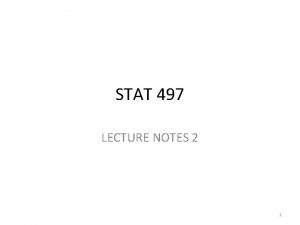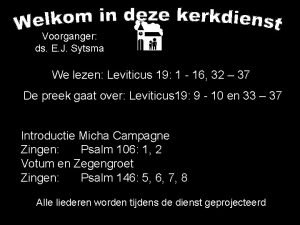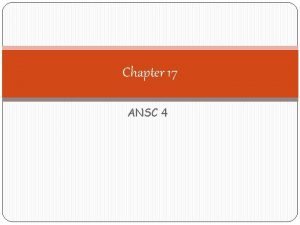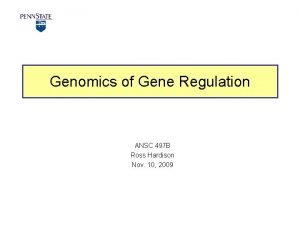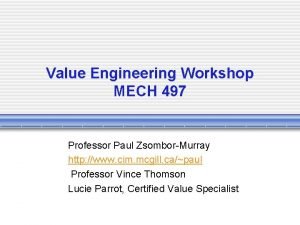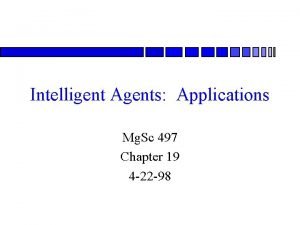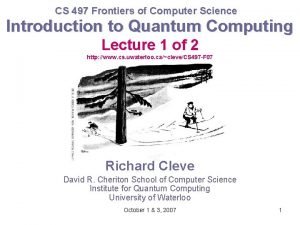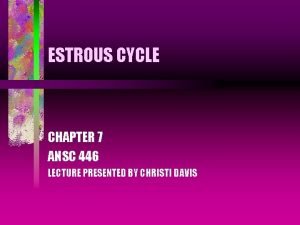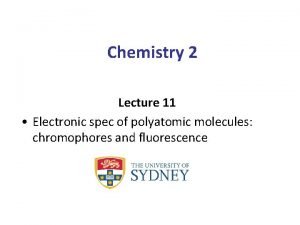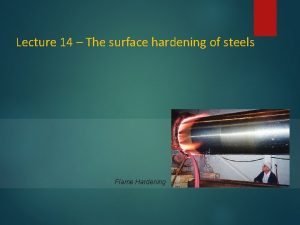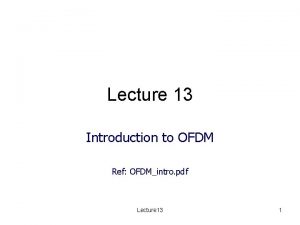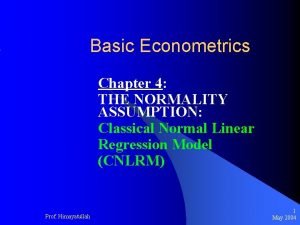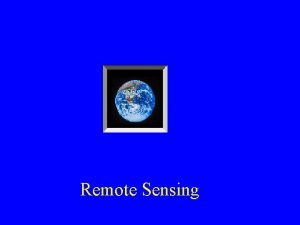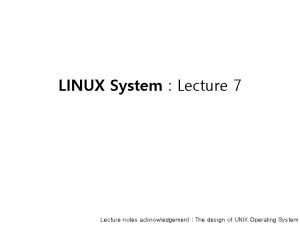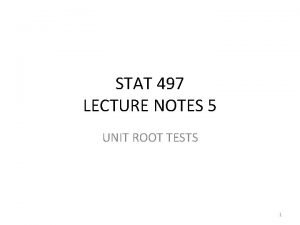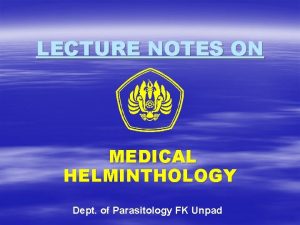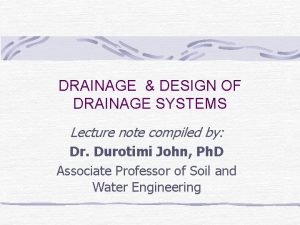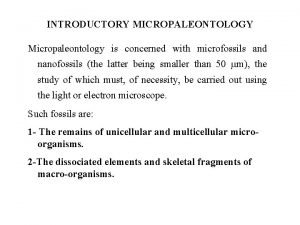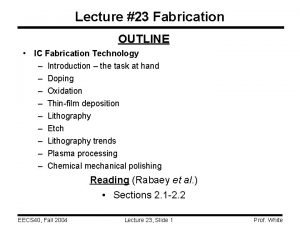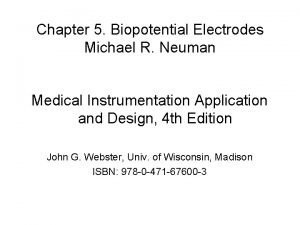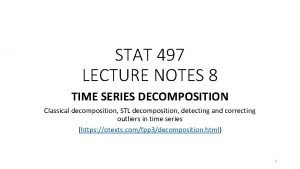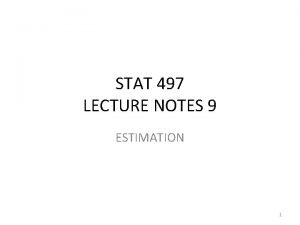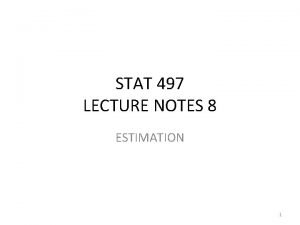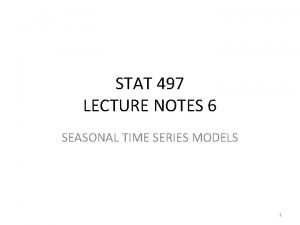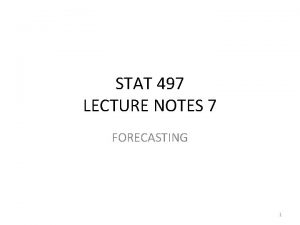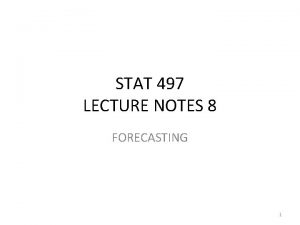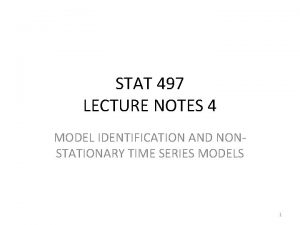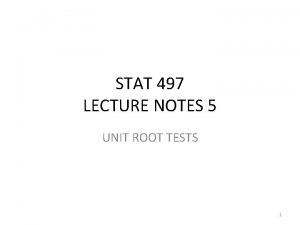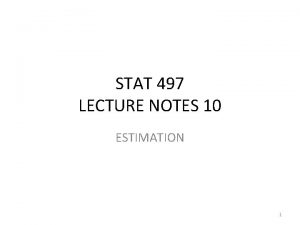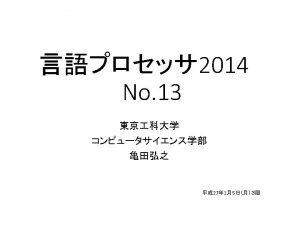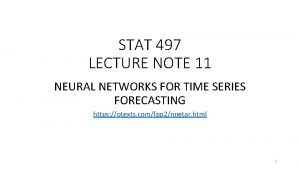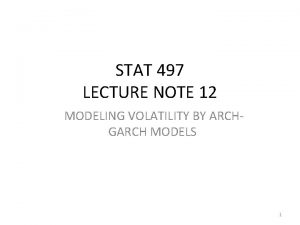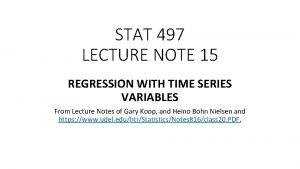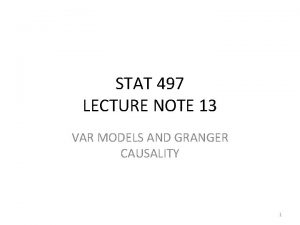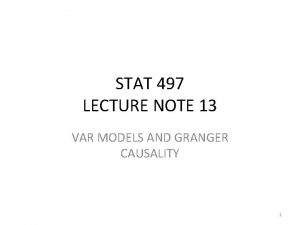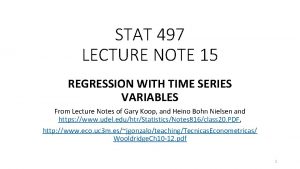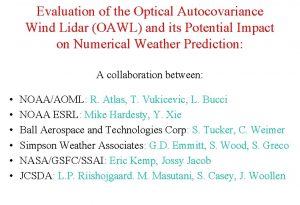STAT 497 LECTURE NOTES 2 1 THE AUTOCOVARIANCE








































- Slides: 40

STAT 497 LECTURE NOTES 2 1

THE AUTOCOVARIANCE AND THE AUTOCORRELATION FUNCTIONS • For a stationary process {Yt}, the autocovariance between Yt and Yt-k is and the autocorrelation function is 2

THE AUTOCOVARIANCE AND THE AUTOCORRELATION FUNCTIONS PROPERTIES: 1. 2. 3. 4. (necessary condition) k and k are positive semidefinite 3 for any set of time points t 1, t 2, …, tn and any real numbers 1, 2, …, n.

Lack of Uniqueness • 4

THE PARTIAL AUTOCORRELATION FUNCTION (PACF) • PACF is the correlation between Yt and Yt-k after their mutual linear dependency on the intervening variables Yt-1, Yt-2, …, Yt-k+1 has been removed. • The conditional correlation is usually referred as the partial autocorrelation in time series. 5

CALCULATION OF PACF 1. REGRESSION APPROACH: Consider a model from a zero mean stationary process where ki denotes the coefficients of Yt k+i and et k is the zero mean error term which is uncorrelated with Yt k+i, i=0, 1, …, k. • Multiply both sides by Yt k+j 6

CALCULATION OF PACF and taking the expectations diving both sides by 0 PACF 7

CALCULATION OF PACF • For j=1, 2, …, k, we have the following system of equations 8

CALCULATION OF PACF • Using Cramer’s rule successively for k=1, 2, … 9

CALCULATION OF PACF 10

CALCULATION OF PACF 2. Levinson and Durbin’s Recursive Formula: 11

WHITE NOISE (WN) PROCESS • A process {at} is called a white noise (WN) process, if it is a sequence of uncorrelated random variables from a fixed distribution with constant mean {E(at)= }, constant variance {Var(at)= } and Cov(Yt, Yt-k)=0 for all k≠ 0. 12

WHITE NOISE (WN) PROCESS • It is a stationary process with autocovariance function Basic Phenomenon: ACF=PACF=0, k 0. 13

WHITE NOISE (WN) PROCESS • White noise (in spectral analysis): white light is produced in which all frequencies (i. e. , colors) are present in equal amount. • Memoryless process • Building block from which we can construct more complicated models • It plays the role of an orthogonal basis in the general vector and function analysis. 14

ESTIMATION OF THE MEAN, AUTOCOVARIANCE AND AUTOCORRELATION • THE SAMPLE MEAN: 15

• • Yt y 1 y 2 y 3. . yn-1 yn BYt=Yt-1 y 2 y 3 y 4. . yn - EYt=Yt+1 y 2. . yn-2 yn-1 16

THE SAMPLE AUTOCOVARIANCE FUNCTION or 17

THE SAMPLE AUTOCORRELATION FUNCTION • A plot versus k a sample correlogram • For large sample sizes, is normally distributed with mean k and variance is approximated by Bartlett’s approximation for processes in which k=0 for k>m. 18

THE SAMPLE AUTOCORRELATION FUNCTION • In practice, i’s are unknown and replaced by their sample estimates, . Hence, we have the following large-lag standard error of : 19

THE SAMPLE AUTOCORRELATION FUNCTION • For a WN process, we have • The ~95% confidence interval for k: For a WN process, it must be close to zero. • Hence, to test the process is WN or not, draw a 2/n 1/2 lines on the sample correlogram. If all are inside the limits, the process could be WN (we need to check the sample PACF, too). 20

THE SAMPLE PARTIAL AUTOCORRELATION FUNCTION • For a WN process, • 2/n 1/2 can be used as critical limits on kk to test the hypothesis of a WN process. 21

BACKSHIFT (OR LAG) OPERATORS • Backshift operator, B is defined as e. g. Random Shock Process: 22

MOVING AVERAGE REPRESENTATION OF A TIME SERIES • Also known as Random Shock Form or Wold (1938) Representation. • Let {Yt} be a time series. For a stationary process {Yt}, we can write {Yt} as a linear combination of sequence of uncorrelated (WN) r. v. s. A GENERAL LINEAR PROCESS: where 0=I, {at} is a 0 mean WN process and 23

MOVING AVERAGE REPRESENTATION OF A TIME SERIES 24

MOVING AVERAGE REPRESENTATION OF A TIME SERIES 25

MOVING AVERAGE REPRESENTATION OF A TIME SERIES • Because they involve infinite sums, to be statinary • Hence, is the required condition for the process to be stationary. 26

AUTOCOVARIANCE GENERATING FUNCTION • For a given sequence of autocovariances k, k=0, 1, 2, … the autocovariance generating function is defined as where the variance of a given process 0 is the coefficient of B 0 and the autocovariance of lag k, k is the coefficient of both Bk and B k. 2 1 27

AUTOCOVARIANCE GENERATING FUNCTION • Using and stationarity where j=0 for j<0. 28

AUTOCORRELATION GENERATING FUNCTION 29

EXAMPLE a) Write the above equation in random shock form. b) Find the autocovariance generating function. 30

AUTOREGRESSIVE REPRESENTATION OF A TIME SERIES • This representation is also known as INVERTED FORM. • Regress the value of Yt at time t on its own past plus a random shock. 31

AUTOREGRESSIVE REPRESENTATION OF A TIME SERIES • It is an invertible process (it is important forecasting). Not every stationary process in invertible (Box and Jenkins, 1978). • Invertibility provides uniqueness of the autocorrelation function. • It means that different time series models can be re-expressed by each other. 32

INVERTIBILITY RULE USING THE RANDOM SHOCK FORM • For a linear process, to be invertible, the roots of (B)=0 as a function of B must lie outside the unit circle. • If is a root of (B), then | |>1. (real number) | | is the absolute value of . (complex number) | | is 33

INVERTIBILITY RULE USING THE RANDOM SHOCK FORM • It can be stationary if the process can be rewritten in a RSF, i. e. , 34

STATIONARITY RULE USING THE INVERTED FORM • For a linear process, to be invertible, the roots of (B)=0 as a function of B must lie outside the unit circle. • If is a root of (B), then | |>1. 35

RANDOM SHOCK FORM AND INVERTED FORM • AR and MA representations are not the model form. Because they contain infinite number of parameters that are impossible to estimate from a finite number of observations. 36

TIME SERIES MODELS • In the Inverted Form of a process, if only finite number of weights are non-zero, i. e. , the process is called AR(p) process. 37

TIME SERIES MODELS • In the Random Shock Form of a process, if only finite number of weights are non-zero, i. e. , the process is called MA(q) process. 38

TIME SERIES MODELS • AR(p) Process: • MA(q) Process: 39

TIME SERIES MODELS • The number of parameters in a model can be large. A natural alternate is the mixed AR and MA process ARMA(p, q) process • For a fixed number of observations, the more parameters in a model, the less efficient is the estimation of the parameters. Choose a simpler model to describe the phenomenon. 40
 Autocovariance generating function
Autocovariance generating function 01:640:244 lecture notes - lecture 15: plat, idah, farad
01:640:244 lecture notes - lecture 15: plat, idah, farad Opwekking 497
Opwekking 497 Ansc 497
Ansc 497 Ansc 497
Ansc 497 Paul zsombor-murray
Paul zsombor-murray Mg 497
Mg 497 Cs 497
Cs 497 Ansc 497
Ansc 497 Financial institutions and markets lecture notes ppt
Financial institutions and markets lecture notes ppt Switch mode power supply lecture notes
Switch mode power supply lecture notes Franck condon principle
Franck condon principle Lecture notes on public sector accounting ghana pdf
Lecture notes on public sector accounting ghana pdf Advanced inorganic chemistry lecture notes
Advanced inorganic chemistry lecture notes Land use planning '' lecture notes
Land use planning '' lecture notes Cyanide hardening
Cyanide hardening Introduction to ofdm
Introduction to ofdm Ppt index
Ppt index Project planning and management lecture notes ppt
Project planning and management lecture notes ppt Land use planning '' lecture notes
Land use planning '' lecture notes Power system dynamics and stability lecture notes
Power system dynamics and stability lecture notes Gujarati basic econometrics lecture notes ppt
Gujarati basic econometrics lecture notes ppt Microwave remote sensing lecture notes
Microwave remote sensing lecture notes Linux lecture notes
Linux lecture notes An introduction to atmospheric physics
An introduction to atmospheric physics Bayesian classification in data mining lecture notes
Bayesian classification in data mining lecture notes Adf.test in r
Adf.test in r Physics 101 lecture notes pdf
Physics 101 lecture notes pdf General parasitology lecture notes
General parasitology lecture notes Foundation engineering lecture notes
Foundation engineering lecture notes Zline 667-36
Zline 667-36 Parallel and distributed computing lecture notes
Parallel and distributed computing lecture notes Random ditch system
Random ditch system Financial engineering lecture notes
Financial engineering lecture notes Project cost management lecture notes
Project cost management lecture notes Obstetrics and gynecology lecture notes ppt
Obstetrics and gynecology lecture notes ppt Micropaleontology definition
Micropaleontology definition Power system dynamics and stability lecture notes
Power system dynamics and stability lecture notes What is a harmonic wave in physics
What is a harmonic wave in physics Ic fabrication technology
Ic fabrication technology Biopotential electrodes lecture notes
Biopotential electrodes lecture notes
